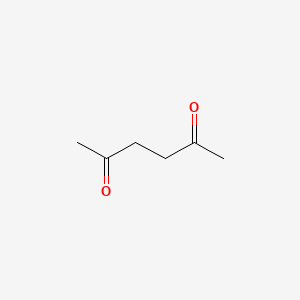| MeSH term | MeSH ID | Detail |
|---|---|---|
| Adenocarcinoma | D000230 | 166 associated lipids |
| Colonic Neoplasms | D003110 | 161 associated lipids |
| Body Weight | D001835 | 333 associated lipids |
| Testicular Diseases | D013733 | 15 associated lipids |
| Occupational Diseases | D009784 | 42 associated lipids |
| Weight Gain | D015430 | 101 associated lipids |
| Brain Diseases | D001927 | 27 associated lipids |
| Neuroblastoma | D009447 | 66 associated lipids |
| Carcinoma, Hepatocellular | D006528 | 140 associated lipids |
| Demyelinating Diseases | D003711 | 15 associated lipids |
2,5-hexanedione
2,5-hexanedione is a lipid of Fatty Acyls (FA) class.
Cross Reference
There are no associated biomedical information in the current reference collection.
Current reference collection contains 1519 references associated with 2,5-hexanedione in LipidPedia. Due to lack of full text of references or no associated biomedical terms are recognized in our current text-mining method, we cannot extract any biomedical terms related to diseases, pathways, locations, functions, genes, lipids, and animal models from the associated reference collection.
Users can download the reference list at the bottom of this page and read the reference manually to find out biomedical information.
Here are additional resources we collected from PubChem and MeSH for 2,5-hexanedione
Possible diseases from mapped MeSH terms on references
We collected disease MeSH terms mapped to the references associated with 2,5-hexanedione
NCBI Entrez Crosslinks
All references with 2,5-hexanedione
Download all related citations| Authors | Title | Published | Journal | PubMed Link |
|---|---|---|---|---|
| Liu HF et al. | [Studying the damages of mouse retina induced by 2,5-hexanedione]. | 2012 | Zhonghua Lao Dong Wei Sheng Zhi Ye Bing Za Zhi | pmid:22804983 |
| Campion SN et al. | Molecular alterations underlying the enhanced disruption of spermatogenesis by 2,5-hexanedione and carbendazim co-exposure. | 2012 | Reprod. Toxicol. | pmid:22382377 |
| Cheng X et al. | Exposure to 2,5-hexanedione can induce neural malformations in chick embryos. | 2012 | Neurotoxicology | pmid:22841600 |
| Lee MY et al. | External quality assessment scheme for biological monitoring of occupational exposure to toxic chemicals. | 2011 | Saf Health Work | pmid:22953206 |
| Yan BC et al. | The high dosage of earthworm (Eisenia andrei) extract decreases cell proliferation and neuroblast differentiation in the mouse hippocampal dentate gyrus. | 2011 | Anat Cell Biol | pmid:22025974 |
| Viarisio D et al. | E6 and E7 from beta HPV38 cooperate with ultraviolet light in the development of actinic keratosis-like lesions and squamous cell carcinoma in mice. | 2011 | PLoS Pathog. | pmid:21779166 |
| Khalil F and Läer S | Physiologically based pharmacokinetic modeling: methodology, applications, and limitations with a focus on its role in pediatric drug development. | 2011 | J. Biomed. Biotechnol. | pmid:21716673 |
| Kakati D and Sarma JC | Microwave assisted solvent free synthesis of 1,3-diphenylpropenones. | 2011 | Chem Cent J | pmid:21329529 |
| Gargouri I et al. | A case study on co-exposure to a mixture of organic solvents in a Tunisian adhesive-producing company. | 2011 | J Occup Med Toxicol | pmid:22082240 |
| Wang Q et al. | Carboxyl-terminus of Hsc70 interacting protein mediates 2,5-hexanedione-induced neurofilament medium chain degradation. | 2011 | Biochem. Pharmacol. | pmid:21219885 |
